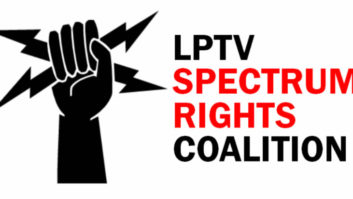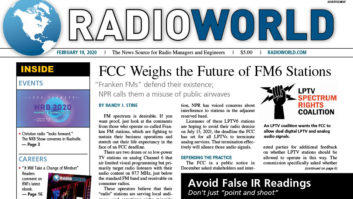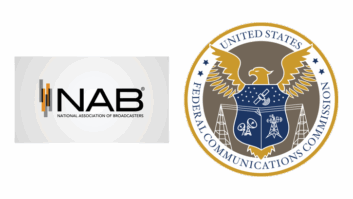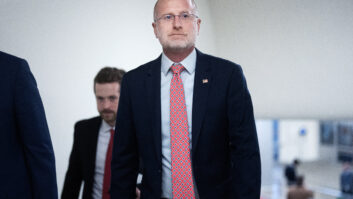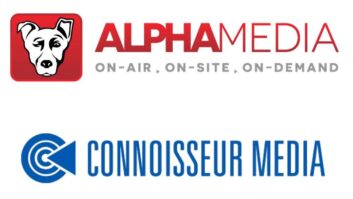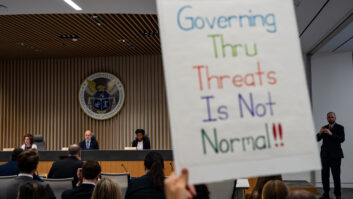FM spectrum is desirable. If you want proof, just look at the comments from those who operate so-called Franken FM stations, which are fighting to sustain their business operations and stretch out their life expectancy in the face of an FCC deadline.
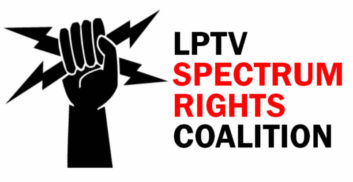
There are two dozen or so low-power TV stations on analog Channel 6 that air limited visual programming but primarily target radio listeners with their audio content on 87.7 MHz, just below the standard FM band and receivable on consumer radios.
These operators believe that their “radio” stations are serving local audiences, and sometimes niche minority populations, with programming and lifesaving information.
Opponents to the dual-mode operation, including National Public Radio, say the stations have flouted FCC rules and are misusing the spectrum. In addition, NPR has voiced concerns about interference to stations in the adjacent reserved band.
Licensees of these LPTV6 stations are hoping to avoid their radio demise on July 13, 2021, the deadline the FCC has set for all LPTVs to terminate analog services. That termination effectively will silence those audio signals.
DEFENDING THE PRACTICE
The FCC in a public notice in December asked stakeholders and interested parties for additional feedback on whether LPTV stations should be allowed to operate in this way. The commission specifically asked whether digital LPTVs should be allowed to operate analog radio services as ancillary or supplementary services.
The intent of the ancillary service rule is to permit DTV stations, including LPTVs, to use a portion of their bandwidth to provide ancillary services on a supplemental basis. When a TV station provides such services and charges the consumer for the specialized service, they pay a regulatory fee of 5% of ancillary revenues made to the FCC.
This is not the first time the commission has taken input about FM6 stations; it asked these questions back in 2014 without taking subsequent action, and it is now “refreshing” its record.
(More than a decade ago, radio engineers in online discussions began calling such stations “Franken FMs,” referring to an unholy mashup reminiscent of Frankenstein’s monster; the term was picked up by Radio World and subsequently has found broader use, including among the latest filed comments. Some operators consider the term pejorative.)
The LPTV Spectrum Rights Coalition is a defender of the practice. In fact, the group says it was instrumental in obtaining a five-year extension of the analog sunset.
“There are no legal or technical barriers to extending the authorization of currently operating analog Channel 6 LPTV stations to offer an analog 87.7 FM audio service after the LPTV digital transition,” it told the FCC in its comments. It said the commission just needs to modify two rules.
“Specifically, the FCC can amend its rules to allow currently operating analog TV6 LPTV stations to: (1) continue their analog TV transmissions after the digital transition on a authorized basis; and (2) utilize independent aural and visual transmitters, all subject to the existing requirement that they adhere to existing FCC rules which require they transmit a digital video signal that can be received by an ATSC receiver. Further, the FCC can carefully tailor these rules so they only apply to stations currently operating on analog Channel 6.”
The coalition wants the FCC to allow a dual digital LPTV and analog audio signal. “The FCC should authorize currently operating analog Channel 6 LPTV stations to continue using a portion of their spectrum to provide an analog aural service on 87.7 FM following the digital transition.”
The coalition said it doesn’t believe the FM6 stations should be charged the 5% ancillary fee for airing the FM signal.
“The 87.7 FM programmers and their LPTV licensee owner are providing the signal free to the public, and should not be charged any fee for doing what is allowable [under] existing rulemaking. Whether a programming service is paying the station licensee a fee to air their programming is irrelevant, and all that matters is that the 87.7 FM signal is free to the public.”
“VITAL” COMPONENT
In essence, operators of FM6 stations are asking for an “analog carve-out” for their 87.7 MHz signal as the TV digital transition continues.
La Invasora produces a format that uses the WTBS(LP) 87.7 FM signal to reach a Spanish-language audience in Atlanta. The ancillary audio service is positioned as the “musical mix channel of Mexican Regional and Pop music for Atlanta.”
Prism Broadcasting Network, licensee of WTBS(LP), supports grandfathering analog 87.7 FM LPTV stations so that they may continue their “valuable and unique” local programming.
“It is only fair that these ongoing successful programming ventures be allowed to continue to serve their local communities with their local programming,” Prism stated in comments.
El Sabor Lazer Radio is a service of Delta Media Corp., broadcasting its Spanish-language programming in Lafayette, La., where it says it is the only commercial Hispanic radio station.
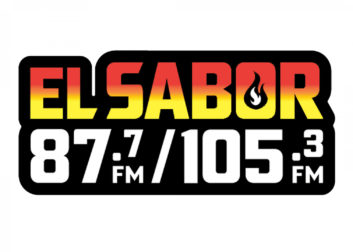
Similarly, AlmaVision Hispanic Network, licensee of TV station WEYS(LP) in Miami, operates AlmaVision Radio on 87.7. It told the FCC that WEYS provides ethnic programming using the FM signal to reach a potential audience of 2.2 million Spanish speakers.
“AlmaVision Hispanic Network supports the grandfathering of analog 87.7 FM LPTV stations such as WEYS(LP) so that they may continue to provide their valuable and unique local programming. It is unquestionably in the public interest that the FCC permit these ongoing successful programming ventures to continue to serve their communities with their local programming,” according to the broadcaster.
In addition to providing Spanish programming and music, the Miami broadcaster said it provides emergency alerts in Spanish and has considerable local support from sponsors of content and local events, as well as advertisers.
“The station is a vital religious, educational and civic component of the Spanish-speaking community in the Miami metro area,” according to AlmaVision Hispanic Network.
Meanwhile, Lovcom Inc. is the licensee of KSHW(LP) television in Sheridan, Wyo., broadcasting sports news and commentary for audio listeners over 87.7 FM. The station is listed as a radio affiliate on the websites of Westwood One and the Colorado Rockies Radio Network.
KSHW(LP) wrote: “The station has a loyal following of listeners who would be harmed should the commission move forward with the elimination of analog LPTV service and not provide Lovcom with the ability to distribute its signal on an ancillary or supplemental basis after the digital transition.
“The impending LPTV digital transition does not have to lead to KSHW(LP)’s existing listeners losing access to programming that they listen to on a daily basis. Allowing LPTV stations to continue to operate an analog FM radio-type service on an ancillary or supplementary basis would be a permissible and efficient use of the spectrum,” it stated, in comments filed by communications attorney John Garziglia of Womble Bond Dickinson on behalf of Lovcom.
Educational Media Foundation is a notable name among those supporting the FM6 stations. EMF is a Christian noncommercial broadcaster that holds licenses for some 300 full-power noncommercial educational broadcast radio stations, many of which operate in the reserved band. But in addition to its full-power stations, EMF airs programming on the analog audio channel of KBKF(LP), San Jose, Calif.
EMF said it sees “no technological or policy reason for ending FM-on-LPTV service and encourages the commission to allow 87.7 MHz San Jose — and stations like it — to continue using Channel 6 to deliver an audio signal after July 13, 2021.”
It concluded: “FM-on-LPTV stations are already operating and not causing interference at the lowest end of the FM band, with the closest NCE channels at 88.1 MHz being second-adjacent and sufficiently protected from interference.”
NPR WEIGHS IN
National Public Radio has taken a strong stance against FM6 stations.
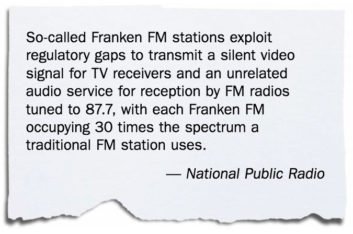 NPR said that authorizing low-power Channel 6 TV stations to operate analog FM radio services after the final digital television conversion deadline would be misguided. It calls Franken FMs “a misuse of public airwaves.”
NPR said that authorizing low-power Channel 6 TV stations to operate analog FM radio services after the final digital television conversion deadline would be misguided. It calls Franken FMs “a misuse of public airwaves.”
NPR and the public radio community believe they have significant stake in this; they believe these stations pose an ongoing threat of harmful interference to the adjacent FM band reserved for NCE stations.
“So-called Franken FM stations exploit regulatory gaps to transmit a silent video signal for TV receivers and an unrelated audio service for reception by FM radios tuned to 87.7, with each Franken FM occupying 30 times the spectrum a traditional FM station uses.”
If the FCC does not kill off these stations outright, NPR says, it must develop new rules to make sure they don’t interfere with noncom signals as well as ensuring that their primary video signal can be received by DTV receiver.
But the LPTV Spectrum Rights Coalition downplayed the issue of interference that has been raised by opponents.
“These concerns are both highly exaggerated within these proceedings and are easily managed in real-world field engineering work. There currently over 20 LPTV stations transmitting analog audio carriers available on 87.7 FM, yet the coalition is not aware of any outstanding complaints about actual interference between the audio signal transmitted by these analog LPTV stations and nearby FM stations on Channels 201 or 202.”
QUESTION OF FAIRNESS
Multicultural Radio Broadcasting Inc. operates radio stations in Los Angeles and New York City. It wrote: “At the heart of this matter are issues of basic fairness. The public was never given notice or a fair opportunity to apply for Channel 6 LPTV stations with the understanding that those stations could fill a dual role as a television and radio station.
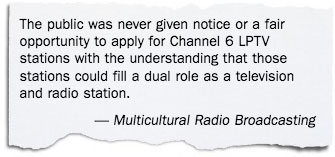 “Likewise, AM and FM stations in communities where Franken FM stations operate are forced to compete with Channel 6 radio stations that were not authorized to provide FM service. Moreover, these Channel 6 radio stations compete directly with radio stations on an uneven playing field because Franken FMs are not subject to the same regulatory and financial obligations as other full service stations.”
“Likewise, AM and FM stations in communities where Franken FM stations operate are forced to compete with Channel 6 radio stations that were not authorized to provide FM service. Moreover, these Channel 6 radio stations compete directly with radio stations on an uneven playing field because Franken FMs are not subject to the same regulatory and financial obligations as other full service stations.”
Effectively, Franken FMs operate with the same power as a Class A full-service FM station, according to Multicultural.
Other detractors say FM6 stations are not EAS-compliant and that they pay lower fees to copyright agencies, such as BMI and ASCAP, creating an unlevel competitive situation for other FMs that do.
Common Frequency Inc., a non-profit that promotes community and college radio, wrote: “The commission writes, ‘Historically, some analog LPTV stations licensed on Channel 6 have operated with very limited visual programming and an audio signal that is programmed like a radio station.’ This is a polite way of stating that these LPTV facilities have ignored Section 73.682 of the commission’s rules and have been broadcasting at 300% of the allowable audio modulation to market itself as a radio station at 87.7 MHz on the FM dial instead of a television station.
“The issue here is continuing this service … would require an aberrant special carve-out of new rules to fit within the commission’s current rules if operated as an FM station.”
The National Association of Broadcasters has never established a position on the FM6 issue, according to a spokesman.
Reply comments in MB Docket No. 03-185 were due to the FCC in early February.
